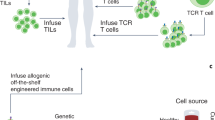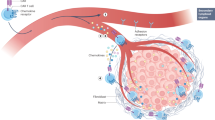Abstract
Genetic tools have been developed to efficiently engineer T-cell specificity and enhance T-cell function. Chimeric antigen receptors (CAR) use the antibody variable segments to direct specificity against cell surface molecules. T-cell receptors (TCR) can redirect T cells to intracellular target proteins, fragments of which are presented in the peptide-binding groove of HLA molecules. A recent clinical trial with CAR-modified T cells redirected against the B-cell lineage antigen CD19 showed dramatic clinical benefit in chronic lymphocytic leukaemia patients. Similarly, impressive clinical responses were seen in melanoma and synovial cell carcinoma with TCR-modified T cells redirected against the melanocyte lineage antigen MART-1 and the testis-cancer antigen NY-ESO-1. However, on and off-target toxicity was associated with most of these clinical responses, and fatal complications have been observed in some patients treated with gene modified T cells. This review will discuss factors that might contribute to toxic side effects of therapy with gene modified T cells, and outline potential strategies to retain anticancer activity while reducing unwanted side effects.
This is a preview of subscription content, access via your institution
Access options
Subscribe to this journal
Receive 12 print issues and online access
$259.00 per year
only $21.58 per issue
Buy this article
- Purchase on Springer Link
- Instant access to full article PDF
Prices may be subject to local taxes which are calculated during checkout
Similar content being viewed by others
References
Apperley JF, Jones L, Hale G, Waldmann H, Hows J, Rombos Y et al. Bone marrow transplantation for patients with chronic myeloid leukaemia: T-cell depletion with Campath-1 reduces the incidence of graft-versus-host disease but may increase the risk of leukaemic relapse. Bone Marrow Transplant 1986; 1: 53–66.
Ferrara JL, Levine JE, Reddy P, Holler E . Graft-versus-host disease. Lancet 2009; 373: 1550–1561.
Horowitz MM, Gale RP, Sondel PM, Goldman JM, Kersey J, Kolb HJ et al. Graft-versus-leukemia reactions after bone marrow transplantation. Blood 1990; 75: 555–562.
Vincent K, Roy DC, Perreault C . Next-generation leukemia immunotherapy. Blood 2011; 118: 2951–2959.
Dudley ME, Yang JC, Sherry R, Hughes MS, Royal R, Kammula U et al. Adoptive cell therapy for patients with metastatic melanoma: evaluation of intensive myeloablative chemoradiation preparative regimens. J Clin Oncol 2008; 26: 5233–5239.
Dudley ME, Wunderlich JR, Robbins PF, Yang JC, Hwu P, Schwartzentruber DJ et al. Cancer regression and autoimmunity in patients after clonal repopulation with antitumor lymphocytes. Science 2002; 298: 850–854.
Pagliara D, Savoldo B . Cytotoxic T lymphocytes for the treatment of viral infections and posttransplant lymphoproliferative disorders in transplant recipients. Curr Opin Infect Dis 2012; 25: 431–437.
Sellar RS, Peggs KS . Therapeutic strategies for the prevention and treatment of cytomegalovirus infection. Expert Opin Biol Ther 2012; 12: 1161–1172.
Eshhar Z . Adoptive cancer immunotherapy using genetically engineered designer T-cells: First steps into the clinic. Curr Opin Mol Ther 2010; 12: 55–63.
Linnemann C, Schumacher TN, Bendle GM . T-cell receptor gene therapy: critical parameters for clinical success. J Invest Dermatol 2011; 131: 1806–1816.
Uttenthal BJ, Chua I, Morris EC, Stauss HJ . Challenges in T cell receptor gene therapy. J Gene Med 2012; 14: 386–399.
Sadelain M, Brentjens R, Riviere I . The promise and potential pitfalls of chimeric antigen receptors. Curr Opin Immunol 2009; 21: 215–223.
Thomas S, Xue SA, Cesco-Gaspere M, San Jose E, Hart DP, Wong V et al. Targeting the Wilms tumor antigen 1 by TCR gene transfer: TCR variants improve tetramer binding but not the function of gene modified human T cells. J Immunol 2007; 179: 5803–5810.
Bendle GM, Linnemann C, Hooijkaas AI, Bies L, de Witte MA, Jorritsma A et al. Lethal graft-versus-host disease in mouse models of T cell receptor gene therapy. Nat Med 2010; 16: 565–570;, 1p following 570.
Cohen CJ, Li YF, El-Gamil M, Robbins PF, Rosenberg SA, Morgan RA . Enhanced antitumor activity of T cells engineered to express T-cell receptors with a second disulfide bond. Cancer Res 2007; 67: 3898–3903.
Kuball J, Dossett ML, Wolfl M, Ho WY, Voss RH, Fowler C et al. Facilitating matched pairing and expression of TCR chains introduced into human T cells. Blood 2007; 109: 2331–2338.
Sommermeyer D, Uckert W . Minimal amino acid exchange in human TCR constant regions fosters improved function of TCR gene-modified T cells. J Immunol 2010; 184: 6223–6231.
Voss RH, Thomas S, Pfirschke C, Hauptrock B, Klobuch S, Kuball J et al. Coexpression of the T-cell receptor constant alpha domain triggers tumor reactivity of single-chain TCR-transduced human T cells. Blood 2010; 115: 5154–5163.
Ochi T, Fujiwara H, Okamoto S, An J, Nagai K, Shirakata T et al. Novel adoptive T-cell immunotherapy using a WT1-specific TCR vector encoding silencers for endogenous TCRs shows marked antileukemia reactivity and safety. Blood 2011; 118: 1495–1503.
Provasi E, Genovese P, Lombardo A, Magnani Z, Liu PQ, Reik A et al. Editing T cell specificity towards leukemia by zinc finger nucleases and lentiviral gene transfer. Nat Med 2012; 18: 807–815.
Kalos M, Levine BL, Porter DL, Katz S, Grupp SA, Bagg A et al. T cells with chimeric antigen receptors have potent antitumor effects and can establish memory in patients with advanced leukemia. Science Translational Medicine 2011; 3: 95ra73.
Porter DL, Levine BL, Kalos M, Bagg A, June CH . Chimeric antigen receptor-modified T cells in chronic lymphoid leukemia. N Engl J Med 2011; 365: 725–733.
Brentjens RJ, Riviere I, Park JH, Davila ML, Wang X, Stefanski J et al. Safety and persistence of adoptively transferred autologous CD19-targeted T cells in patients with relapsed or chemotherapy refractory B-cell leukemias. Blood 2011; 118: 4817–4828.
Chmielewski M, Hombach A, Heuser C, Adams GP, Abken H . T cell activation by antibody-like immunoreceptors: increase in affinity of the single-chain fragment domain above threshold does not increase T cell activation against antigen-positive target cells but decreases selectivity. J Immunol 2004; 173: 7647–7653.
Robbins PF, Morgan RA, Feldman SA, Yang JC, Sherry RM, Dudley ME et al. Tumor regression in patients with metastatic synovial cell sarcoma and melanoma using genetically engineered lymphocytes reactive with NY-ESO-1. J Clin Oncol 2011; 29: 917–924.
Thomas S, Xue SA, Bangham CR, Jakobsen BK, Morris EC, Stauss HJ . Human T cells expressing affinity-matured TCR display accelerated responses but fail to recognize low density of MHC-peptide antigen. Blood 2011; 118: 319–329.
Valitutti S, Lanzavecchia A . Serial triggering of TCRs: a basis for the sensitivity and specificity of antigen recognition. Immunology Today 1997; 18: 299–304.
Valitutti S, Muller S, Cella M, Padovan E, Lanzavecchia A . Serial triggering of many T-cell receptors by a few peptide-MHC complexes. Nature 1995; 375: 148–151.
Johnson LA, Morgan RA, Dudley ME, Cassard L, Yang JC, Hughes MS et al. Gene therapy with human and mouse T-cell receptors mediates cancer regression and targets normal tissues expressing cognate antigen. Blood 2009; 114: 535–546.
Parkhurst MR, Yang JC, Langan RC, Dudley ME, Nathan DA, Feldman SA et al. T cells targeting carcinoembryonic antigen can mediate regression of metastatic colorectal cancer but induce severe transient colitis. Mol Ther 2011; 19: 620–626.
Kochenderfer JN, Dudley ME, Feldman SA, Wilson WH, Spaner DE, Maric I et al. B-cell depletion and remissions of malignancy along with cytokine-associated toxicity in a clinical trial of anti-CD19 chimeric-antigen-receptor-transduced T cells. Blood 2012; 119: 2709–2720.
Weber J, Yang JC, Topalian SL, Parkinson DR, Schwartzentruber DS, Ettinghausen SE et al. Phase I trial of subcutaneous interleukin-6 in patients with advanced malignancies. J Clin Oncol 1993; 11: 499–506.
Morgan RA, Yang JC, Kitano M, Dudley ME, Laurencot CM, Rosenberg SA . Case report of a serious adverse event following the administration of T cells transduced with a chimeric antigen receptor recognizing ERBB2. Mol Ther 2010; 18: 843–851.
Brentjens R, Yeh R, Bernal Y, Riviere I, Sadelain M . Treatment of chronic lymphocytic leukemia with genetically targeted autologous T cells: case report of an unforeseen adverse event in a phase I clinical trial. Mol Ther 2010; 18: 666–668.
Di Stasi A, Tey SK, Dotti G, Fujita Y, Kennedy-Nasser A, Martinez C et al. Inducible apoptosis as a safety switch for adoptive cell therapy. N Engl J Med 2011; 365: 1673–1683.
Russo V, Bondanza A, Ciceri F, Bregni M, Bordignon C, Traversari C et al. A dual role for genetically modified lymphocytes in cancer immunotherapy. Trends Mol Med 2012; 18: 193–200.
Acknowledgements
The authors are supported by grants from Leukaemia & Lymphoma Research UK, Medical Research Council, Experimental Cancer Medicine Centre, EU ATTACK and ATTRACT Consortium.
Author information
Authors and Affiliations
Corresponding authors
Ethics declarations
Competing interests
HJS is on the scientific advisory board of Cell Medica.
Rights and permissions
About this article
Cite this article
Stauss, H., Morris, E. Immunotherapy with gene-modified T cells: limiting side effects provides new challenges. Gene Ther 20, 1029–1032 (2013). https://doi.org/10.1038/gt.2013.34
Received:
Revised:
Accepted:
Published:
Issue Date:
DOI: https://doi.org/10.1038/gt.2013.34
Keywords
This article is cited by
-
Dual drug-loaded PLA nanoparticles bypassing drug resistance for improved leukemia therapy
Journal of Nanoparticle Research (2019)
-
CD8+ T‐cell specificity is compromised at a defined MHCI/CD8 affinity threshold
Immunology & Cell Biology (2017)
-
Development of T cells carrying two complementary chimeric antigen receptors against glypican-3 and asialoglycoprotein receptor 1 for the treatment of hepatocellular carcinoma
Cancer Immunology, Immunotherapy (2017)
-
Metabolic communication in tumors: a new layer of immunoregulation for immune evasion
Journal for ImmunoTherapy of Cancer (2016)
-
CD4+ and CD8+ TCRβ repertoires possess different potentials to generate extraordinarily high-avidity T cells
Scientific Reports (2016)



